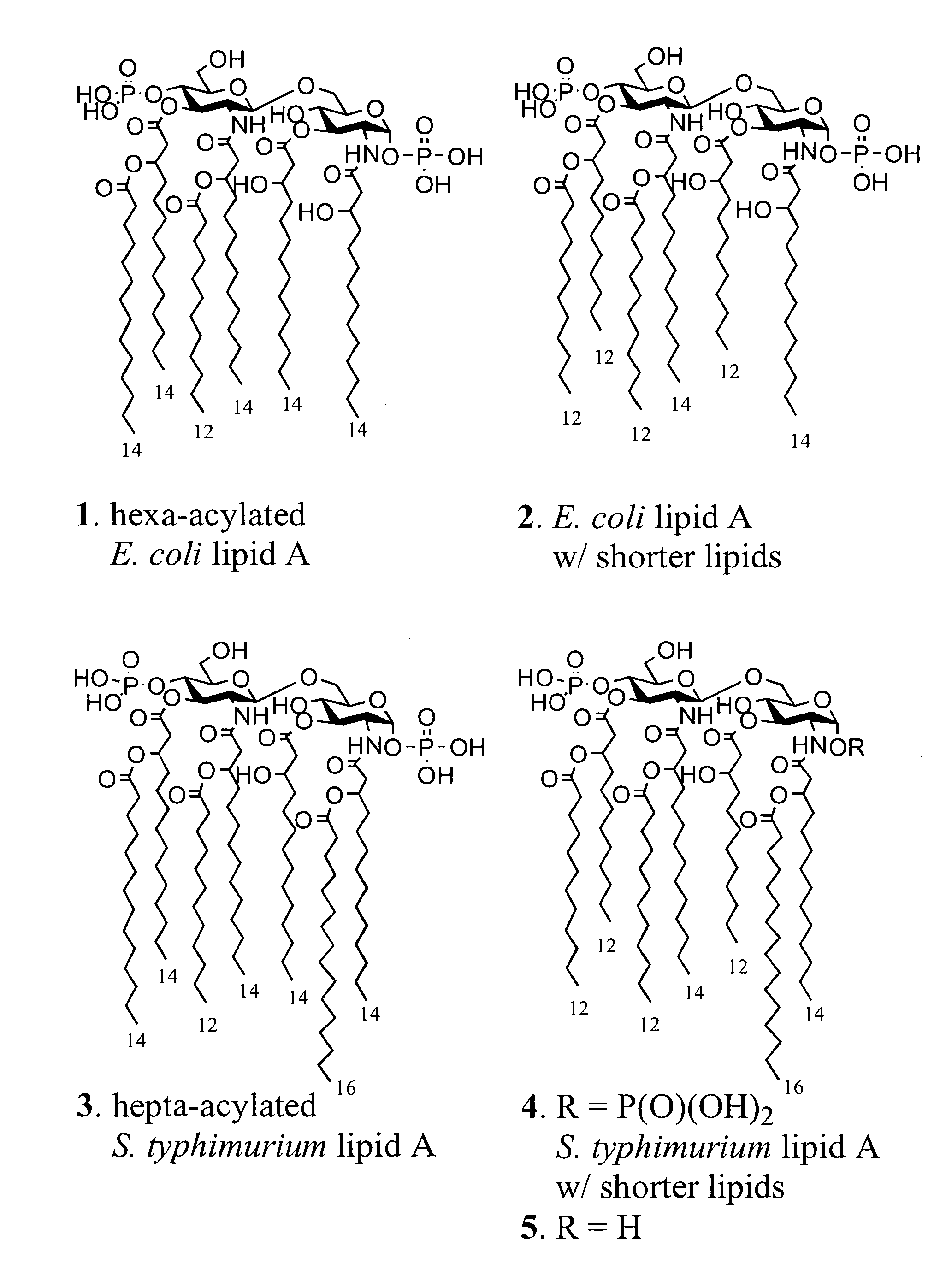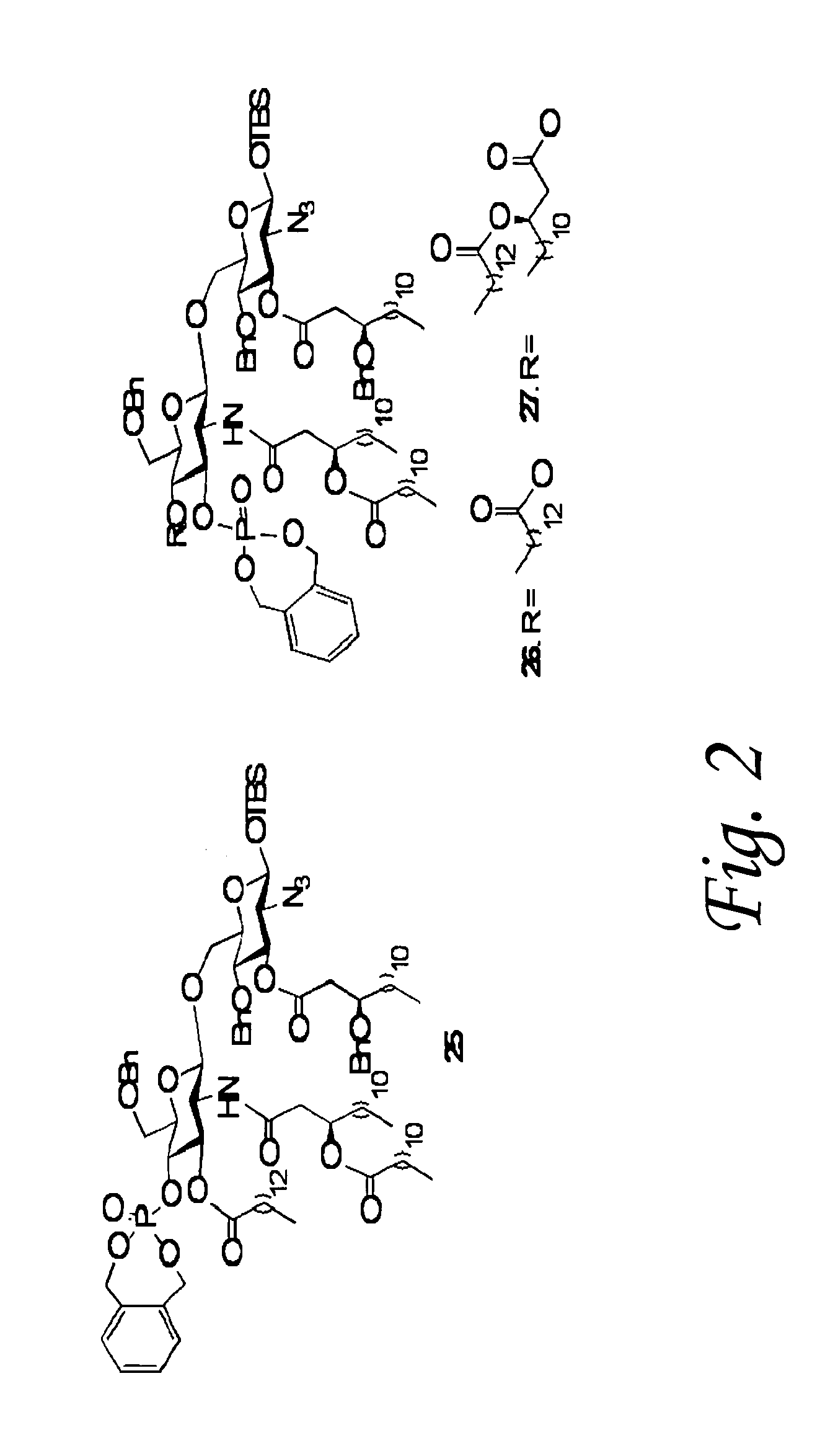Synthetic lipid a derivative
a technology of synthetic lipids and derivatives, applied in the field of innate immune systems, can solve the problems of heterogeneity in the structure of lipids, bacterial cell wall complicating the use of either, and difficult to interpret innate immune responses
- Summary
- Abstract
- Description
- Claims
- Application Information
AI Technical Summary
Problems solved by technology
Method used
Image
Examples
example 1
Modulation of Innate Immune Responses with Synthetic Lipid A Derivatives
[0091]The lipid A moiety of lipopolysaccharides (LPS) initiates innate immune responses by interacting with Toll-like receptor 4 (TLR4) which results in the production of a wide range of cytokines. Derivatives of lipid A show potential for use as immuno-modulators for the treatment of a wide range of diseases and as adjuvants for vaccinations. Development to these ends requires a detailed knowledge of patterns of cytokines induced by a wide range of derivatives. This information is difficult to obtain by using isolated compounds due to structural heterogeneity and possible contaminations with other inflammatory components. To address this problem, we have developed a synthetic approach that provides easy access to a wide range of lipid As by employing a common disaccharide building block functionalized with a versatile set of protecting groups. The strategy was employed for the preparation of lipid As derived fr...
example ii
Innate Immune Responses of Synthetic Lipid A Derivatives of Neisseria meningitidis
[0147]Differences in the pattern and chemical nature of fatty acids of lipid A of Neisseria meningitides lipooligosaccharides (LOS) and Escherichia coli lipopolysaccharides (LPS) may account for differences in inflammatory properties. Furthermore, there are indications that dimeric 3-deoxy-D-manno-oct-2-ulosonic acid (KDO) moieties of LOS and LPS enhance biological activities. Heterogeneity in the structure of lipid A and possible contaminations with other inflammatory components have made it difficult to confirm these observations. To address these problems, a highly convergent approach for the synthesis of a lipid A derivative containing KDO has been developed, which relies on the ability to selectively remove or unmask in a sequential manner an isopropylidene acetal, 9-fluorenylmethoxycarbonyl (Fmoc), allyloxycarbonate (Alloc), azide, and thexyldimethylsilyl (TDS) ether (Zhang et al., 2008 Chemistr...
example iii
Synthetic Tetra-Acylated Lipid As Derived from Porphyromonas gingivalis are Antagonists of Human TLR4
[0196]Tetra-acylated lipid As derived from Porphyromonas gingivalis LPS have been synthesized using a key disaccharide intermediate functionalized with levulinate (Lev), allyloxycarbonate (Alloc) and anomeric dimethylthexylsilyl (TDS) as orthogonal protecting groups and 9-fluorenylmethoxycarbamate (Fmoc) and azido as amino protecting groups (Zhang et al., 2008 Org. Biomol. Chem. 6:3371-3381; Electronica Supplementary Information for Zhang et al., 2008 Org. Biomol. Chem. 6:3371-3381 available at the RSC Publishing site on the World Wide Web at rsc.org / suppdata / OB / b8 / b809090d / b809090d.pdf). Furthermore, an efficient cross metathesis has been employed for the preparation of the unusual branched R-(3)-hydroxy-13-methyltetradecanic acid and (R)-3-hexadecanoyloxy-15-methyl-hexadecanoic acid of P. gingivalis lipid A. Biological studies have shown that the synthetic lipid As can not activate...
PUM
| Property | Measurement | Unit |
|---|---|---|
| concentrations | aaaaa | aaaaa |
| body weight | aaaaa | aaaaa |
| incubation time | aaaaa | aaaaa |
Abstract
Description
Claims
Application Information
 Login to View More
Login to View More - R&D
- Intellectual Property
- Life Sciences
- Materials
- Tech Scout
- Unparalleled Data Quality
- Higher Quality Content
- 60% Fewer Hallucinations
Browse by: Latest US Patents, China's latest patents, Technical Efficacy Thesaurus, Application Domain, Technology Topic, Popular Technical Reports.
© 2025 PatSnap. All rights reserved.Legal|Privacy policy|Modern Slavery Act Transparency Statement|Sitemap|About US| Contact US: help@patsnap.com



